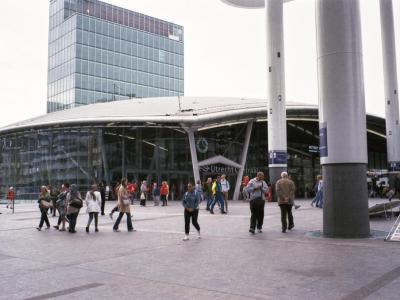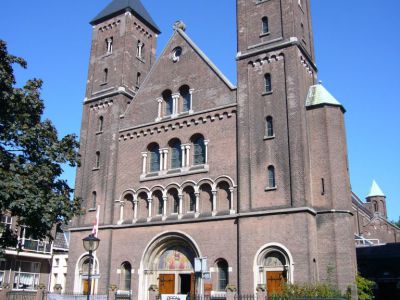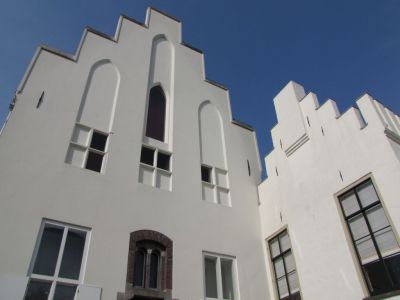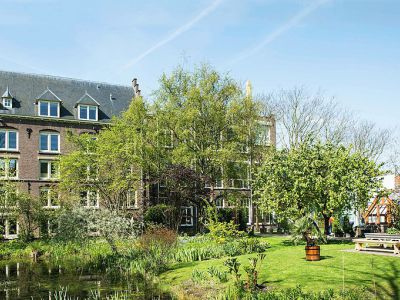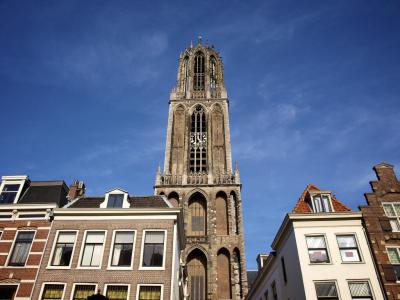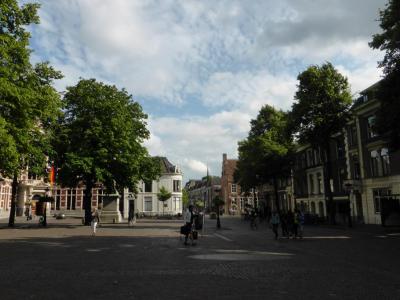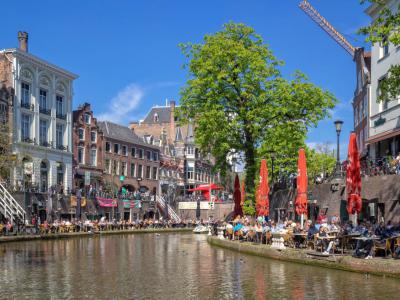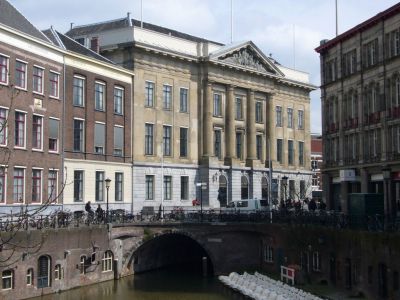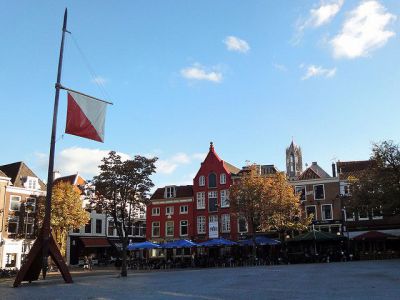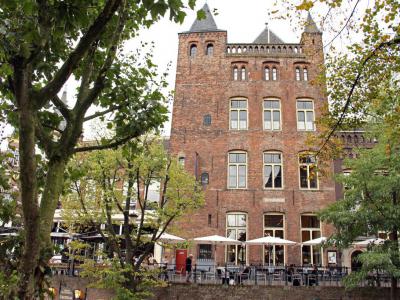Custom Walk in Utrecht, Netherlands by jphiliplong_5ffe2 created on 2025-04-14
Guide Location: Netherlands » Utrecht
Guide Type: Custom Walk
# of Sights: 10
Tour Duration: 2 Hour(s)
Travel Distance: 3.9 Km or 2.4 Miles
Share Key: TGPRD
Guide Type: Custom Walk
# of Sights: 10
Tour Duration: 2 Hour(s)
Travel Distance: 3.9 Km or 2.4 Miles
Share Key: TGPRD
How It Works
Please retrieve this walk in the GPSmyCity app. Once done, the app will guide you from one tour stop to the next as if you had a personal tour guide. If you created the walk on this website or come to the page via a link, please follow the instructions below to retrieve the walk in the app.
Retrieve This Walk in App
Step 1. Download the app "GPSmyCity: Walks in 1K+ Cities" on Apple App Store or Google Play Store.
Step 2. In the GPSmyCity app, download(or launch) the guide "Utrecht Map and Walking Tours".
Step 3. Tap the menu button located at upper right corner of the "Walks" screen and select "Retrieve custom walk". Enter the share key: TGPRD
1) Utrecht Centraal (Utrecht Central Station)
Utrecht Central Station (Station Utrecht Centraal) is the beating heart of the Dutch transit system. As the largest and busiest railway station in the Netherlands, it serves as a crucial hub integrating trains, trams, buses, and bicycles into one seamless transportation network. Its strategic central location makes it the country's most important railway junction, handling over 1,000 departures daily and accommodating more than 200,000 passengers per day.
The station's history dates back to December 18, 1843, when the Dutch Rhine Railway Company established the first railway station on Utrecht’s territory. By 1938, it became the city’s central station after the closure of Maliebaan Station and a reconfiguration of the railway lines. A fire in 1938 severely damaged the station, leading to reconstruction efforts. However, by the 1970s, the old station building was demolished to make way for Hoog Catharijne, then Europe's largest enclosed shopping mall, resulting in a station without a distinct entrance.
As passenger numbers surged, the station underwent multiple expansions in 1989 and 1995 to relieve congestion. A more ambitious transformation took place between 2011 and 2016 when a modern, spacious station hall was constructed as part of a broader redevelopment of the Utrecht station area. Designed by Benthem Crouwel Architekten, the new structure features a distinctive curved roof with three sweeping arches-one for the railway station and two for the adjacent bus and tram hubs. The station was also physically separated from Hoog Catharijne, reasserting its identity as a standalone transport landmark.
Beyond its railway operations, Utrecht Central Station boasts the world’s largest bicycle parking facility, accommodating thousands of cyclists, and serves as the country’s busiest bus station. With its modern infrastructure and efficient connectivity, it remains a vital gateway for commuters and travelers across the Netherlands.
The station's history dates back to December 18, 1843, when the Dutch Rhine Railway Company established the first railway station on Utrecht’s territory. By 1938, it became the city’s central station after the closure of Maliebaan Station and a reconfiguration of the railway lines. A fire in 1938 severely damaged the station, leading to reconstruction efforts. However, by the 1970s, the old station building was demolished to make way for Hoog Catharijne, then Europe's largest enclosed shopping mall, resulting in a station without a distinct entrance.
As passenger numbers surged, the station underwent multiple expansions in 1989 and 1995 to relieve congestion. A more ambitious transformation took place between 2011 and 2016 when a modern, spacious station hall was constructed as part of a broader redevelopment of the Utrecht station area. Designed by Benthem Crouwel Architekten, the new structure features a distinctive curved roof with three sweeping arches-one for the railway station and two for the adjacent bus and tram hubs. The station was also physically separated from Hoog Catharijne, reasserting its identity as a standalone transport landmark.
Beyond its railway operations, Utrecht Central Station boasts the world’s largest bicycle parking facility, accommodating thousands of cyclists, and serves as the country’s busiest bus station. With its modern infrastructure and efficient connectivity, it remains a vital gateway for commuters and travelers across the Netherlands.
2) Sint-Gertrudiskathedraal (St. Gertrude's Cathedral)
Saint Gertrude's Cathedral, located on Willemsplantsoen in Utrecht, serves as the main church of the Old Catholic Church and the seat of the Old Catholic Archbishop. Built between 1912 and 1914, it was designed by E.G. Wentink Jr. in the neo-Romanesque style, chosen as a tribute to the long-lost Saint Mary's Church that once stood nearby.
The cathedral's double west towers dominate its park-facing side, while a three-sided apse completes the structure. Inside, a wooden barrel vault spans the nave, adorned with a painting of Christ as the Good Shepherd. The murals, primarily geometric and abstract, add to the cathedral’s unique atmosphere. Its inventory of religious artifacts, including paintings, sculptures, church silver, and relics, comes from various disused Old Catholic churches.
A highlight is the altar, which houses over 1,700 relics, stored in hundreds of boxes. Among them is a piece of Saint Willibrord’s rib, a sacred treasure for the faithful.
Behind the cathedral stands its predecessor, the Gertrudis Chapel, a former clandestine church dating back to 1634. Originally built for the parish of Geertekerk, the chapel became the cathedral church of the Old Catholics after the Old Catholic Schism of 1723. A rare survivor of its kind, the chapel underwent significant renovations in 1697 and was fully restored between 1991 and 1993.
Today, Saint Gertrude’s Cathedral and its historic chapel remain important symbols of Old Catholic heritage in the Netherlands.
The cathedral's double west towers dominate its park-facing side, while a three-sided apse completes the structure. Inside, a wooden barrel vault spans the nave, adorned with a painting of Christ as the Good Shepherd. The murals, primarily geometric and abstract, add to the cathedral’s unique atmosphere. Its inventory of religious artifacts, including paintings, sculptures, church silver, and relics, comes from various disused Old Catholic churches.
A highlight is the altar, which houses over 1,700 relics, stored in hundreds of boxes. Among them is a piece of Saint Willibrord’s rib, a sacred treasure for the faithful.
Behind the cathedral stands its predecessor, the Gertrudis Chapel, a former clandestine church dating back to 1634. Originally built for the parish of Geertekerk, the chapel became the cathedral church of the Old Catholics after the Old Catholic Schism of 1723. A rare survivor of its kind, the chapel underwent significant renovations in 1697 and was fully restored between 1991 and 1993.
Today, Saint Gertrude’s Cathedral and its historic chapel remain important symbols of Old Catholic heritage in the Netherlands.
3) Duitse Huis (Teutonic House)
The Teutonic House (Duitse Huis) is a historic complex in Utrecht with origins dating back to 1348. Established by the Bailiwick of Utrecht of the Teutonic Order, it initially served as a monastery and headquarters for the knights. Over the centuries, the complex has undergone significant transformations, reflecting its rich history and evolving functions.
The Teutonic Order, a prominent Christian military order alongside the Knights Templar and Knights Hospitaller, was active in the Holy Land and the Baltic region. To support their missions, they established branches in Western Europe, including the Bailiwick of Utrecht in 1231. In 1348, the order constructed the Teutonic House between Utrecht's city wall and Springweg, serving both as a monastery and administrative center.
Between December 1545 and February 1546, Emperor Charles V resided at the Teutonic House during a chapter meeting of the Order of the Golden Fleece. This significant event was attended by notable figures, including Charles's sister, Mary of Hungary.
By 1580, amidst the Reformation, the States of Utrecht pressured Catholic institutions like the Bailiwick to dissolve and repurpose their assets for charitable causes. In response, the Teutonic Order in the Netherlands converted to Protestantism, allowing them to retain their properties and continue their operations.
In 1807, Louis Bonaparte acquired the property, leading the Teutonic Order to relocate. Under King William I, a modern military hospital was constructed on the site, completed in 1823. This hospital remained operational until 1990.
After the hospital's closure, the Bailiwick of Utrecht repurchased and renovated the site, reopening their headquarters in 1995. Today, they operate as a charity aiding vulnerable groups and preserving a collection of medieval manuscripts, coins, and artworks.
A portion of the restored complex has been transformed into the Grand Hotel Karel V, a five-star establishment that opened in 1999. The hotel features 121 rooms, conference facilities, a health center, a bar, a brasserie, and a restaurant. Renovations uncovered a Roman cemetery (40 BC–275 AD), likely linked to Traiectum. In 2007, the garden wing was renamed the Roman Wing in its honor.
Today, the Teutonic House stands as a testament to Utrecht's layered history, seamlessly blending its medieval origins with modern functionalities.
The Teutonic Order, a prominent Christian military order alongside the Knights Templar and Knights Hospitaller, was active in the Holy Land and the Baltic region. To support their missions, they established branches in Western Europe, including the Bailiwick of Utrecht in 1231. In 1348, the order constructed the Teutonic House between Utrecht's city wall and Springweg, serving both as a monastery and administrative center.
Between December 1545 and February 1546, Emperor Charles V resided at the Teutonic House during a chapter meeting of the Order of the Golden Fleece. This significant event was attended by notable figures, including Charles's sister, Mary of Hungary.
By 1580, amidst the Reformation, the States of Utrecht pressured Catholic institutions like the Bailiwick to dissolve and repurpose their assets for charitable causes. In response, the Teutonic Order in the Netherlands converted to Protestantism, allowing them to retain their properties and continue their operations.
In 1807, Louis Bonaparte acquired the property, leading the Teutonic Order to relocate. Under King William I, a modern military hospital was constructed on the site, completed in 1823. This hospital remained operational until 1990.
After the hospital's closure, the Bailiwick of Utrecht repurchased and renovated the site, reopening their headquarters in 1995. Today, they operate as a charity aiding vulnerable groups and preserving a collection of medieval manuscripts, coins, and artworks.
A portion of the restored complex has been transformed into the Grand Hotel Karel V, a five-star establishment that opened in 1999. The hotel features 121 rooms, conference facilities, a health center, a bar, a brasserie, and a restaurant. Renovations uncovered a Roman cemetery (40 BC–275 AD), likely linked to Traiectum. In 2007, the garden wing was renamed the Roman Wing in its honor.
Today, the Teutonic House stands as a testament to Utrecht's layered history, seamlessly blending its medieval origins with modern functionalities.
4) The Oude Hortus (Old Hortus)
Nestled in the heart of Utrecht, The Old Hortus (Oude Hortus) is a serene green escape, offering a moment of tranquility away from the city's daily hustle. Once the botanical garden of Utrecht University from 1723 to 1920, this historic site has evolved into a museum garden, providing visitors with a glimpse into centuries of botanical history.
The garden is divided into several sections, including a cottage garden and the Regiustuin, a medicinal garden inspired by early botanical research. It is home to a remarkable variety of plants and trees, including one of the oldest Ginkgo biloba trees in the Netherlands, over 250 years old.
The origins of the botanical garden in Utrecht date back to 1639, but it was in 1723 that the hortus botanicus settled between Nieuwegracht and Lange Nieuwstraat. After losing its function as a university botanical garden in 1920, many of its plants were transferred to Cantonspark in Baarn and the greenhouses on Lange Nieuwstraat. The site saw gradual transformations, including a period when parts of it served as a parking lot.
By the 1960s, as Utrecht University shifted its facilities to De Uithof, the garden's botanical role diminished. However, in 1991, its fate took a turn when the Friends of the Oude Hortus Foundation-a group of residents, Rotary Club members, and volunteers-stepped in to preserve and redesign the space. This effort culminated in 1996 when the Utrecht University Museum was established in the former Botanical Laboratory, and the garden was officially recognized as a museum garden under the name Oude Hortus.
Today, The Old Hortus offers not only a retreat for relaxation but also a window into three and a half centuries of botanical evolution. It remains a hidden gem for visitors seeking inspiration, a quiet stroll, or simply a cup of coffee amidst history and nature.
The garden is divided into several sections, including a cottage garden and the Regiustuin, a medicinal garden inspired by early botanical research. It is home to a remarkable variety of plants and trees, including one of the oldest Ginkgo biloba trees in the Netherlands, over 250 years old.
The origins of the botanical garden in Utrecht date back to 1639, but it was in 1723 that the hortus botanicus settled between Nieuwegracht and Lange Nieuwstraat. After losing its function as a university botanical garden in 1920, many of its plants were transferred to Cantonspark in Baarn and the greenhouses on Lange Nieuwstraat. The site saw gradual transformations, including a period when parts of it served as a parking lot.
By the 1960s, as Utrecht University shifted its facilities to De Uithof, the garden's botanical role diminished. However, in 1991, its fate took a turn when the Friends of the Oude Hortus Foundation-a group of residents, Rotary Club members, and volunteers-stepped in to preserve and redesign the space. This effort culminated in 1996 when the Utrecht University Museum was established in the former Botanical Laboratory, and the garden was officially recognized as a museum garden under the name Oude Hortus.
Today, The Old Hortus offers not only a retreat for relaxation but also a window into three and a half centuries of botanical evolution. It remains a hidden gem for visitors seeking inspiration, a quiet stroll, or simply a cup of coffee amidst history and nature.
5) Dom Tower (must see)
Dom Tower is located right on Dom Square, but you can't miss it. It is the tallest church tower in the Netherlands. You can join a guided tour of the tower and enjoy the incredible vistas from the top observation platform.
During the trip up the tower, you will climb 465 steps. Luckily, the tower is full of stories from its long history. During the hour-long tour, the guide will make lots of stops to discuss the various chapels and galleries along the way.
Dom Tower was built from 1321 to 1382 and designed by John of Hainaut. At the time, it was one of the largest towers in Europe. It was part of Saint Martin's Cathedral, which was never fully completed. The unfinished nave collapsed in 1674 and left Dom Tower as a freestanding building. Overall, the tower is 112.5 meters tall.
The tower has always been a multifunctional structure--it serves as a belfry and contains private chapels. Over the city's history, it has also served as a watchtower, with quarters for the tower guard inside.
The tower features a carillon, the largest bell of which weighs 8,200 kilograms (18,000 pounds) and has a diameter of 227 centimeters (89 inches). Like the tower, the carillon has been restored several times, most recently in 1972. At that time, it was expanded to include 50 bells.
The tower has just undergone another massive renovation project. During the process, a lift was added so that you could skip the workout and just enjoy the view.
Why You Should Visit:
Most people do not consider a trip to Utrecht complete without visiting Dom Tower and seeing the city from above. The tower is known as the symbol of the city.
You can see a 360-degree panoramic view of the city and its surroundings from the viewing galleries. You can see both Amsterdam and Rotterdam from the top on clear days. The upper gallery is 95 meters (311 feet) above street level.
But the tour of Dom Tower is also an extraordinary glimpse into the history of the area. The Romans founded the city on this very site, and guides share the city's lore throughout the ages.
During the trip up the tower, you will climb 465 steps. Luckily, the tower is full of stories from its long history. During the hour-long tour, the guide will make lots of stops to discuss the various chapels and galleries along the way.
Dom Tower was built from 1321 to 1382 and designed by John of Hainaut. At the time, it was one of the largest towers in Europe. It was part of Saint Martin's Cathedral, which was never fully completed. The unfinished nave collapsed in 1674 and left Dom Tower as a freestanding building. Overall, the tower is 112.5 meters tall.
The tower has always been a multifunctional structure--it serves as a belfry and contains private chapels. Over the city's history, it has also served as a watchtower, with quarters for the tower guard inside.
The tower features a carillon, the largest bell of which weighs 8,200 kilograms (18,000 pounds) and has a diameter of 227 centimeters (89 inches). Like the tower, the carillon has been restored several times, most recently in 1972. At that time, it was expanded to include 50 bells.
The tower has just undergone another massive renovation project. During the process, a lift was added so that you could skip the workout and just enjoy the view.
Why You Should Visit:
Most people do not consider a trip to Utrecht complete without visiting Dom Tower and seeing the city from above. The tower is known as the symbol of the city.
You can see a 360-degree panoramic view of the city and its surroundings from the viewing galleries. You can see both Amsterdam and Rotterdam from the top on clear days. The upper gallery is 95 meters (311 feet) above street level.
But the tour of Dom Tower is also an extraordinary glimpse into the history of the area. The Romans founded the city on this very site, and guides share the city's lore throughout the ages.
6) Domplein (Dom Square)
Just like many other medieval European cities, Utrecht has its fair share of city squares. But it has been said that there is only one that matters--Dom Square. Home to the impressive Dom Church, history abounds above and below this beautiful plaza.
Dom Square's history goes back to Roman times. The original settlement was a castellum at a ford near the river Rhine. This original settlement was called Trajectum, which translates to "crossing point." As a monument to that history, the city has lights in the road surface that outline the wall of the original castellum.
The best way to taste the centuries of history here is to visit the DOMunder Museum, the entrance to which is right in the center of the square. From there, you can see parts of the original castellum and foundations from the original Dom Church.
In the 11th century, this was the site of the Lofen imperial palace. Unfortunately, a massive nine-day-long fire in 1253 burned it to the ground, along with most other buildings in the square. However, parts of the palace are still visible in some of the cellars of surrounding buildings. These are being opened soon and will eventually be part of the DOMunder Museum.
The most prominent feature in the square today is the Domkerk, otherwise known as Dom Church. Opposite the church is Dom Tower, a Gothic bell tower with 465 steps that leads to a fantastic panoramic view of Utrecht. The original cathedral connected the two--the tower was meant to be part of the larger structure. But a tornado in 1674 destroyed the unfinished nave, and the two structures were never again connected.
On the south side of the square lies the University of Utrecht. Between it and the Dom Church is one of the can't-miss sights at the square, the beautiful Dom Church Gardens.
Several monuments are dispersed throughout the square, including one statue of Count Jan van Nassau. Van Nassau is shown carrying a piece of paper, his Union of Utrecht--the charter he drew in 1579 between several Dutch regions.
There is also a monument dedicated to the resistance movement during World War II. The statue was dedicated in 1949 and created by Corinne Franzén-Heslenfeld.
Dom Square's history goes back to Roman times. The original settlement was a castellum at a ford near the river Rhine. This original settlement was called Trajectum, which translates to "crossing point." As a monument to that history, the city has lights in the road surface that outline the wall of the original castellum.
The best way to taste the centuries of history here is to visit the DOMunder Museum, the entrance to which is right in the center of the square. From there, you can see parts of the original castellum and foundations from the original Dom Church.
In the 11th century, this was the site of the Lofen imperial palace. Unfortunately, a massive nine-day-long fire in 1253 burned it to the ground, along with most other buildings in the square. However, parts of the palace are still visible in some of the cellars of surrounding buildings. These are being opened soon and will eventually be part of the DOMunder Museum.
The most prominent feature in the square today is the Domkerk, otherwise known as Dom Church. Opposite the church is Dom Tower, a Gothic bell tower with 465 steps that leads to a fantastic panoramic view of Utrecht. The original cathedral connected the two--the tower was meant to be part of the larger structure. But a tornado in 1674 destroyed the unfinished nave, and the two structures were never again connected.
On the south side of the square lies the University of Utrecht. Between it and the Dom Church is one of the can't-miss sights at the square, the beautiful Dom Church Gardens.
Several monuments are dispersed throughout the square, including one statue of Count Jan van Nassau. Van Nassau is shown carrying a piece of paper, his Union of Utrecht--the charter he drew in 1579 between several Dutch regions.
There is also a monument dedicated to the resistance movement during World War II. The statue was dedicated in 1949 and created by Corinne Franzén-Heslenfeld.
7) Oudegracht (Old Canal) (must see)
This canal is likely the most famous in the city since it runs the entire length of the town from north to south. It is two kilometers long and connects Kromme Rijn and the Vecht.
When the Romans settled in the area, they chose the spot where the Vecht split from the Rhine. Unfortunately, the Rhine had begun to silt, and a dam built in 1122 threatened to limit navigation to Utrecht drastically. So a series of canals were built to compensate for these issues.
These canals served several purposes. First, they connected the town to the Rhine and the North Sea for trade routes. They also served a defensive purpose--many were used for moats around castles. Plus, the silt dug to make the canals was piled on the sides, which braced the community from flooding.
By creating a waterworks system, water levels in the canal are kept at a constant level. This enabled many homes and buildings along the canal to build quays and storage cellars, which eventually grew into wharves. By the 15th century, the city has a two-kilometer-long harbor of wharves with storage cellars.
An impressive collection of 16 beautiful bridges cross the Oudegracht. Most of these have two arches each, but a few have only one arch.
When the Romans settled in the area, they chose the spot where the Vecht split from the Rhine. Unfortunately, the Rhine had begun to silt, and a dam built in 1122 threatened to limit navigation to Utrecht drastically. So a series of canals were built to compensate for these issues.
These canals served several purposes. First, they connected the town to the Rhine and the North Sea for trade routes. They also served a defensive purpose--many were used for moats around castles. Plus, the silt dug to make the canals was piled on the sides, which braced the community from flooding.
By creating a waterworks system, water levels in the canal are kept at a constant level. This enabled many homes and buildings along the canal to build quays and storage cellars, which eventually grew into wharves. By the 15th century, the city has a two-kilometer-long harbor of wharves with storage cellars.
An impressive collection of 16 beautiful bridges cross the Oudegracht. Most of these have two arches each, but a few have only one arch.
8) Stadhuis van Utrecht (Utrecht City Hall)
Utrecht City Hall, located on the Town Hall Bridge spanning the Oudegracht, is a complex of buildings that have undergone centuries of transformation. Its current form reflects a blend of medieval, Renaissance, neoclassical, and contemporary architectural influences.
The story of Utrecht City Hall begins in 1343 when the city's aldermen were forced to vacate their previous meeting place in the trading district of Stathe due to the expansion of the Buurkerk. They relocated to the Hasenberg building on the Oudegracht, at the site of the current town hall. In 1537, the city council moved into the twelfth-century Lichtenberg house next to Hasenberg, which still retains its original wharf cellar.
Between 1537 and 1547, under Emperor Charles V, the city council merged the Hasenberg and Lichtenberg buildings, adding a Renaissance façade to Hasenberg while Lichtenberg retained its medieval look. In 1547, the Huidenbrug and Broodbrug bridges were consolidated into the Town Hall Bridge. A bell tower with a carillon by Jacob van Eyck was added to Hasenberg in 1582. Later expansions included converting Keyserrijk into a weighhouse in 1614 and unifying structures on the Oudkerkhof with a classical side wall in 1643.
In 1826, architect Johannes van Embden replaced Hasenberg and Lichtenberg with a neoclassical building, completed in 1830 with a Bentheimer sandstone façade and four Doric columns. In 1957, Pieter d'Hont added a pediment sculpture symbolizing municipal functions. Expansions continued, including a uniform façade along the Oudegracht in 1934 and a Civil Affairs building by Johannes Izak Planjer in 1935.
In 1997, architect Enric Miralles was commissioned to renovate Utrecht City Hall, demolishing much of the Civil Affairs building and altering the neoclassical structure while preserving its outer walls and reception hall. The entrance moved to Korte Minrebroederstraat, and Queen Beatrix inaugurated the revamped hall on August 30, 2000. Today, the city hall reflects Utrecht’s evolving architectural history while remaining its administrative center.
The story of Utrecht City Hall begins in 1343 when the city's aldermen were forced to vacate their previous meeting place in the trading district of Stathe due to the expansion of the Buurkerk. They relocated to the Hasenberg building on the Oudegracht, at the site of the current town hall. In 1537, the city council moved into the twelfth-century Lichtenberg house next to Hasenberg, which still retains its original wharf cellar.
Between 1537 and 1547, under Emperor Charles V, the city council merged the Hasenberg and Lichtenberg buildings, adding a Renaissance façade to Hasenberg while Lichtenberg retained its medieval look. In 1547, the Huidenbrug and Broodbrug bridges were consolidated into the Town Hall Bridge. A bell tower with a carillon by Jacob van Eyck was added to Hasenberg in 1582. Later expansions included converting Keyserrijk into a weighhouse in 1614 and unifying structures on the Oudkerkhof with a classical side wall in 1643.
In 1826, architect Johannes van Embden replaced Hasenberg and Lichtenberg with a neoclassical building, completed in 1830 with a Bentheimer sandstone façade and four Doric columns. In 1957, Pieter d'Hont added a pediment sculpture symbolizing municipal functions. Expansions continued, including a uniform façade along the Oudegracht in 1934 and a Civil Affairs building by Johannes Izak Planjer in 1935.
In 1997, architect Enric Miralles was commissioned to renovate Utrecht City Hall, demolishing much of the Civil Affairs building and altering the neoclassical structure while preserving its outer walls and reception hall. The entrance moved to Korte Minrebroederstraat, and Queen Beatrix inaugurated the revamped hall on August 30, 2000. Today, the city hall reflects Utrecht’s evolving architectural history while remaining its administrative center.
9) Neude (New Square)
Cafes, shops, and restaurants surround this city square in Utrecht. If you're looking for a place to go for a bite to eat, or maybe to pass the time at an outdoor restaurant, start your search here. There's always something happening, and the square is a popular meeting place for students from Utrecht University.
The primary building here is the towering Neude Library. The building was formerly the central post office. The square and library have many displays of sculpture and modern art.
The square hosts community events, from concerts, markets, and even random things like beach volleyball competitions. You can find a meal or drink to suit every budget, and there are several lodging options nearby as well.
The primary building here is the towering Neude Library. The building was formerly the central post office. The square and library have many displays of sculpture and modern art.
The square hosts community events, from concerts, markets, and even random things like beach volleyball competitions. You can find a meal or drink to suit every budget, and there are several lodging options nearby as well.
10) Oudaen City Castle
Standing proudly on Oudegracht, Oudaen City Castle is one of Utrecht’s most significant architectural monuments. Originally built in the 1270s, this imposing medieval city castle was once the residence of noble families who sought both grandeur and security along the picturesque Oudegracht. Unlike typical homes of the time, Oudaen was designed with a large main building for prestige and a smaller, more easily heated side structure for comfort.
The castle’s early history is tied to the Zoudenbalch family, one of Utrecht’s most powerful lineages. In 1395, ownership passed to the Oudaen family, whose name remains attached to the property to this day. However, Oudaen was more than just a noble residence-it bore witness to key historical events. During the siege of Vredenburg Castle (1576–1577), it suffered significant damage, and remnants of bullet holes on the rear façade still stand as silent testimony. Later, in 1713, during negotiations for the Treaty of Utrecht, the French envoy Melchior de Polignac was accommodated here.
By 1758, Oudaen had transitioned from a private residence to a retirement home, a role it maintained for over two centuries. A 19th-century renovation saw some changes, including the removal of Gothic arches from the front façade and the replacement of its battlements with a balustrade, though medieval elements remain preserved on its side and rear facades.
After a major restoration in 1986, Oudaen embraced a new identity-one that balances its centuries-old heritage with modern hospitality. Today, it operates as a restaurant, brewery, and event venue, inviting visitors to dine within its historic walls. With locally sourced cuisine and on-site craft beer, it has become a favorite for both locals and tourists. Whether you’re indulging in a meal, savoring a freshly brewed beer, or hosting an event, Oudaen City Castle offers a unique experience where history meets contemporary Dutch gastronomy.
The castle’s early history is tied to the Zoudenbalch family, one of Utrecht’s most powerful lineages. In 1395, ownership passed to the Oudaen family, whose name remains attached to the property to this day. However, Oudaen was more than just a noble residence-it bore witness to key historical events. During the siege of Vredenburg Castle (1576–1577), it suffered significant damage, and remnants of bullet holes on the rear façade still stand as silent testimony. Later, in 1713, during negotiations for the Treaty of Utrecht, the French envoy Melchior de Polignac was accommodated here.
By 1758, Oudaen had transitioned from a private residence to a retirement home, a role it maintained for over two centuries. A 19th-century renovation saw some changes, including the removal of Gothic arches from the front façade and the replacement of its battlements with a balustrade, though medieval elements remain preserved on its side and rear facades.
After a major restoration in 1986, Oudaen embraced a new identity-one that balances its centuries-old heritage with modern hospitality. Today, it operates as a restaurant, brewery, and event venue, inviting visitors to dine within its historic walls. With locally sourced cuisine and on-site craft beer, it has become a favorite for both locals and tourists. Whether you’re indulging in a meal, savoring a freshly brewed beer, or hosting an event, Oudaen City Castle offers a unique experience where history meets contemporary Dutch gastronomy.
